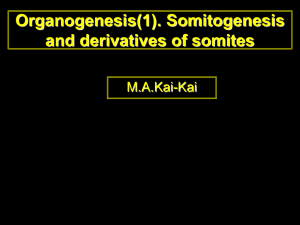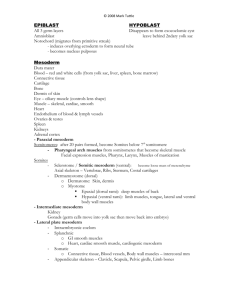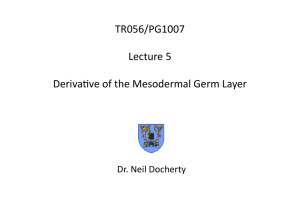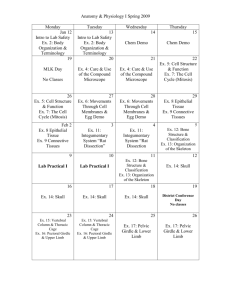Musculo-Skeletal System
advertisement
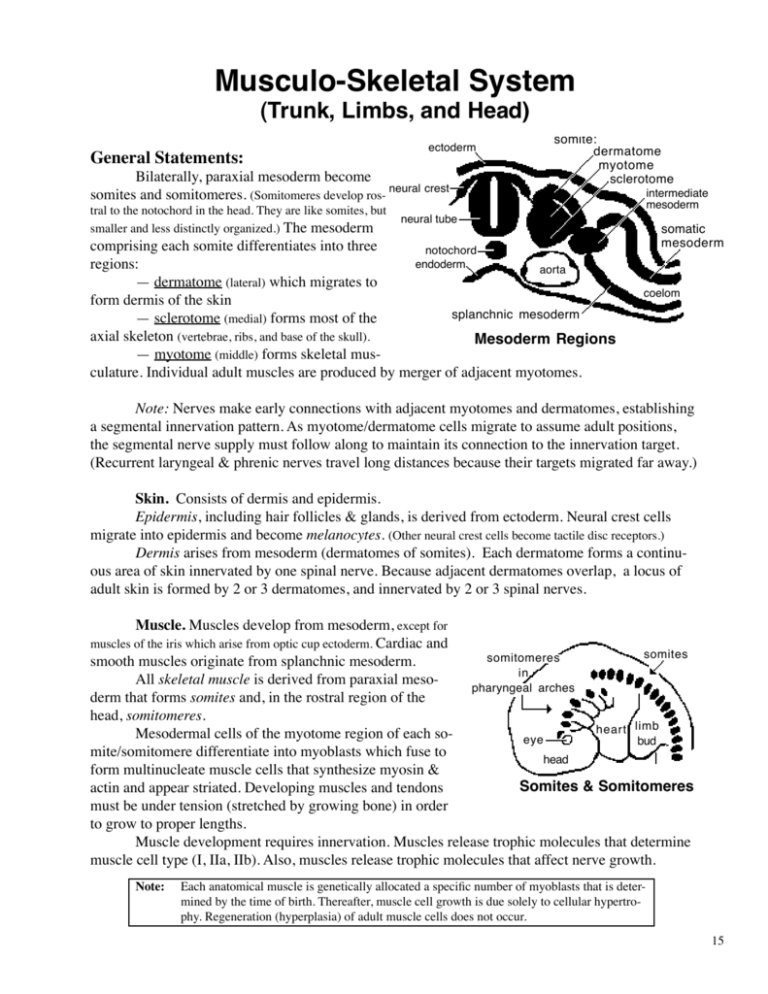
Musculo-Skeletal System (Trunk, Limbs, and Head) General Statements: ectoderm Bilaterally, paraxial mesoderm become somites and somitomeres. (Somitomeres develop ros- neural crest tral to the notochord in the head. They are like somites, but smaller and less distinctly organized.) The mesoderm somite: dermatome myotome sclerotome intermediate mesoderm neural tube comprising each somite differentiates into three notochord endoderm regions: aorta — dermatome (lateral) which migrates to form dermis of the skin splanchnic mesoderm — sclerotome (medial) forms most of the axial skeleton (vertebrae, ribs, and base of the skull). Mesoderm Regions — myotome (middle) forms skeletal musculature. Individual adult muscles are produced by merger of adjacent myotomes. somatic mesoderm coelom Note: Nerves make early connections with adjacent myotomes and dermatomes, establishing a segmental innervation pattern. As myotome/dermatome cells migrate to assume adult positions, the segmental nerve supply must follow along to maintain its connection to the innervation target. (Recurrent laryngeal & phrenic nerves travel long distances because their targets migrated far away.) Skin. Consists of dermis and epidermis. Epidermis, including hair follicles & glands, is derived from ectoderm. Neural crest cells migrate into epidermis and become melanocytes. (Other neural crest cells become tactile disc receptors.) Dermis arises from mesoderm (dermatomes of somites). Each dermatome forms a continuous area of skin innervated by one spinal nerve. Because adjacent dermatomes overlap, a locus of adult skin is formed by 2 or 3 dermatomes, and innervated by 2 or 3 spinal nerves. Muscle. Muscles develop from mesoderm, except for muscles of the iris which arise from optic cup ectoderm. Cardiac and somites somitomeres smooth muscles originate from splanchnic mesoderm. in All skeletal muscle is derived from paraxial mesopharyngeal arches derm that forms somites and, in the rostral region of the head, somitomeres. heart limb Mesodermal cells of the myotome region of each soeye bud mite/somitomere differentiate into myoblasts which fuse to head form multinucleate muscle cells that synthesize myosin & Somites & Somitomeres actin and appear striated. Developing muscles and tendons must be under tension (stretched by growing bone) in order to grow to proper lengths. Muscle development requires innervation. Muscles release trophic molecules that determine muscle cell type (I, IIa, IIb). Also, muscles release trophic molecules that affect nerve growth. Note: Each anatomical muscle is genetically allocated a specific number of myoblasts that is determined by the time of birth. Thereafter, muscle cell growth is due solely to cellular hypertrophy. Regeneration (hyperplasia) of adult muscle cells does not occur. 15 The INNNERVATION PROBLEM: How to establish connections between nerves and their targets during embryonic development? Would you . . . A] First, have targets migrate to their locations, then have nerves find them. B] First, connect nerves to targets, then have nerves follow targets as they migrate. Musculo-Skeletal System (Trunk, Limbs, and Head) General Statements: ectoderm Bilaterally, paraxial mesoderm become somites and somitomeres. (Somitomeres develop ros- neural crest tral to the notochord in the head. They are like somites, but smaller and less distinctly organized.) The mesoderm somite: dermatome myotome sclerotome intermediate mesoderm neural tube comprising each somite differentiates into three notochord endoderm regions: aorta — dermatome (lateral) which migrates to form dermis of the skin splanchnic mesoderm — sclerotome (medial) forms most of the axial skeleton (vertebrae, ribs, and base of the skull). Mesoderm Regions — myotome (middle) forms skeletal musculature. Individual adult muscles are produced by merger of adjacent myotomes. somatic mesoderm coelom Note: Nerves make early connections with adjacent myotomes and dermatomes, establishing a segmental innervation pattern. As myotome/dermatome cells migrate to assume adult positions, the segmental nerve supply must follow along to maintain its connection to the innervation target. (Recurrent laryngeal & phrenic nerves travel long distances because their targets migrated far away.) Skin. Consists of dermis and epidermis. Epidermis, including hair follicles & glands, is derived from ectoderm. Neural crest cells migrate into epidermis and become melanocytes. (Other neural crest cells become tactile disc receptors.) Dermis arises from mesoderm (dermatomes of somites). Each dermatome forms a continuous area of skin innervated by one spinal nerve. Because adjacent dermatomes overlap, a locus of adult skin is formed by 2 or 3 dermatomes, and innervated by 2 or 3 spinal nerves. Muscle. Muscles develop from mesoderm, except for muscles of the iris which arise from optic cup ectoderm. Cardiac and somites somitomeres smooth muscles originate from splanchnic mesoderm. in All skeletal muscle is derived from paraxial mesopharyngeal arches derm that forms somites and, in the rostral region of the head, somitomeres. heart limb Mesodermal cells of the myotome region of each soeye bud mite/somitomere differentiate into myoblasts which fuse to head form multinucleate muscle cells that synthesize myosin & Somites & Somitomeres actin and appear striated. Developing muscles and tendons must be under tension (stretched by growing bone) in order to grow to proper lengths. Muscle development requires innervation. Muscles release trophic molecules that determine muscle cell type (I, IIa, IIb). Also, muscles release trophic molecules that affect nerve growth. Note: Each anatomical muscle is genetically allocated a specific number of myoblasts that is determined by the time of birth. Thereafter, muscle cell growth is due solely to cellular hypertrophy. Regeneration (hyperplasia) of adult muscle cells does not occur. 15 Musculo-Skeletal System (Trunk, Limbs, and Head) General Statements: ectoderm Bilaterally, paraxial mesoderm become somites and somitomeres. (Somitomeres develop ros- neural crest tral to the notochord in the head. They are like somites, but smaller and less distinctly organized.) The mesoderm somite: dermatome myotome sclerotome intermediate mesoderm neural tube comprising each somite differentiates into three notochord endoderm regions: aorta — dermatome (lateral) which migrates to form dermis of the skin splanchnic mesoderm — sclerotome (medial) forms most of the axial skeleton (vertebrae, ribs, and base of the skull). Mesoderm Regions — myotome (middle) forms skeletal musculature. Individual adult muscles are produced by merger of adjacent myotomes. somatic mesoderm coelom Note: Nerves make early connections with adjacent myotomes and dermatomes, establishing a segmental innervation pattern. As myotome/dermatome cells migrate to assume adult positions, the segmental nerve supply must follow along to maintain its connection to the innervation target. (Recurrent laryngeal & phrenic nerves travel long distances because their targets migrated far away.) Skin. Consists of dermis and epidermis. Epidermis, including hair follicles & glands, is derived from ectoderm. Neural crest cells migrate into epidermis and become melanocytes. (Other neural crest cells become tactile disc receptors.) Dermis arises from mesoderm (dermatomes of somites). Each dermatome forms a continuous area of skin innervated by one spinal nerve. Because adjacent dermatomes overlap, a locus of adult skin is formed by 2 or 3 dermatomes, and innervated by 2 or 3 spinal nerves. Muscle. Muscles develop from mesoderm, except for muscles of the iris which arise from optic cup ectoderm. Cardiac and somites somitomeres smooth muscles originate from splanchnic mesoderm. in All skeletal muscle is derived from paraxial mesopharyngeal arches derm that forms somites and, in the rostral region of the head, somitomeres. heart limb Mesodermal cells of the myotome region of each soeye bud mite/somitomere differentiate into myoblasts which fuse to head form multinucleate muscle cells that synthesize myosin & Somites & Somitomeres actin and appear striated. Developing muscles and tendons must be under tension (stretched by growing bone) in order to grow to proper lengths. Muscle development requires innervation. Muscles release trophic molecules that determine muscle cell type (I, IIa, IIb). Also, muscles release trophic molecules that affect nerve growth. Note: Each anatomical muscle is genetically allocated a specific number of myoblasts that is determined by the time of birth. Thereafter, muscle cell growth is due solely to cellular hypertrophy. Regeneration (hyperplasia) of adult muscle cells does not occur. 15 Bone. Bones originate from paraxial mesoderm (endochondral axial skeleton from sclerotomes), somatic mesoderm (endochondral appendicular skeleton), or ectomesenchyme (intramembranous bones of the calvaria and face from neural crest). Ligaments, tendons, and muscle-related connective tissue originate from local mesenchyme or ectomesenchyme. Thus, most bones are formed endochondrally (ossification of a cartilage model), but bones of the calvaria (top of the skull) and the face are formed intramembranously (ectomesenchyme cells become osteoblasts directly rather than becoming chondroblasts). Endochondral bone formation: — local mesenchyme undergoes condensation; some cells differentiate into chondroblasts — chondroblasts secrete matrix to produce a cartilage model of the future bone; the model is surrounded by perichondral fibrous tissue — the diaphysis of the cartilage model undergoes ossification first; epiphyseal ossification occurs later; physis ossification is postponed until bones stop growing in length. — overall bone shape is genetically determined; surface irregularities of bone are acquired due to localized tension (stress) produced by ligaments and tendons. Joints. Condensation of mesenchyme produces an interzone region within perichondral tissue connecting adjacent cartilage models of bones. According to the nature of the future joint, the interzone becomes fibrous connective tissue, or fibrocartilage, or a synovial cavity. Synovial joints form as follows: — mesenchyme at the center of the interzone undergoes cavitation and the tissue bordering the cavity become synovial membrane; uneven expansion of the synovial cavity creates synovial folds (the cavitation synovial cavity perichondral layer interzone ligament cartilage (bone) interzone mesenchyme also forms intra-articular ligaments and tendons where these are present); synovial membrane Synovial Joint Development fibrous capsule — perichondral tissue surrounding the interzone becomes joint capsule and localized thickenings of the joint capsule forms ligaments. Note: Muscle activity is essential for proper synovial joint development after the joint cavity develops. Joints must move during in utero and postnatal develop ment to prevent ankylosis (fixed/frozen joint). Regional Specifics Trunk Region: Skeletal musculature is formed by somite myotomes which fuse to form broad muscles that are segmentally innervated (each myotome brings its own innervation as it merges with adjacent myotomes). Myotome accumulations segregate into a dorsal mass (epimere) innervated by dorsal branches of spinal nerves and a ventral mass (hypomere) innervated by ventral branches of spinal nerves. The epimere becomes epaxial muscles and the hypomere becomes hypaxial muscles. Sclerotomes give rise to vertebrae and ribs. The sternum develops differently, from chondrification/ossification of somatic mesenchyme of the ventral thorax. 16 Bone. Bones originate from paraxial mesoderm (endochondral axial skeleton from sclerotomes), somatic mesoderm (endochondral appendicular skeleton), or ectomesenchyme (intramembranous bones of the calvaria and face from neural crest). Ligaments, tendons, and muscle-related connective tissue originate from local mesenchyme or ectomesenchyme. Thus, most bones are formed endochondrally (ossification of a cartilage model), but bones of the calvaria (top of the skull) and the face are formed intramembranously (ectomesenchyme cells become osteoblasts directly rather than becoming chondroblasts). Endochondral bone formation: — local mesenchyme undergoes condensation; some cells differentiate into chondroblasts — chondroblasts secrete matrix to produce a cartilage model of the future bone; the model is surrounded by perichondral fibrous tissue — the diaphysis of the cartilage model undergoes ossification first; epiphyseal ossification occurs later; physis ossification is postponed until bones stop growing in length. — overall bone shape is genetically determined; surface irregularities of bone are acquired due to localized tension (stress) produced by ligaments and tendons. Joints. Condensation of mesenchyme produces an interzone region within perichondral tissue connecting adjacent cartilage models of bones. According to the nature of the future joint, the interzone becomes fibrous connective tissue, or fibrocartilage, or a synovial cavity. Synovial joints form as follows: — mesenchyme at the center of the interzone undergoes cavitation and the tissue bordering the cavity become synovial membrane; uneven expansion of the synovial cavity creates synovial folds (the cavitation synovial cavity perichondral layer interzone ligament cartilage (bone) interzone mesenchyme also forms intra-articular ligaments and tendons where these are present); synovial membrane Synovial Joint Development fibrous capsule — perichondral tissue surrounding the interzone becomes joint capsule and localized thickenings of the joint capsule forms ligaments. Note: Muscle activity is essential for proper synovial joint development after the joint cavity develops. Joints must move during in utero and postnatal develop ment to prevent ankylosis (fixed/frozen joint). Regional Specifics Trunk Region: Skeletal musculature is formed by somite myotomes which fuse to form broad muscles that are segmentally innervated (each myotome brings its own innervation as it merges with adjacent myotomes). Myotome accumulations segregate into a dorsal mass (epimere) innervated by dorsal branches of spinal nerves and a ventral mass (hypomere) innervated by ventral branches of spinal nerves. The epimere becomes epaxial muscles and the hypomere becomes hypaxial muscles. Sclerotomes give rise to vertebrae and ribs. The sternum develops differently, from chondrification/ossification of somatic mesenchyme of the ventral thorax. 16 Formation of Vertebrae and Ribs: — sclerotome regions of somites migrate & become a continuous mass surrounding the notochord and neural tube. Thus the original somite segmentation is lost — the continuous mass differentiates into diffuse & dense regions per original sclerotome. The diffuse region from one somite combines with the dense region of an adjacent somite to produce a cartilage model of one vertebra. — between newly formed vertebrae (intervertebral disc regions) sclerotome mesenchyme forms annulus fibrous and notochord forms nucleus pulposus (notochord degenerates in the region of the vertebral body) — ribs develop as processes of thoracic vertebrae. Note: As a result of the above re-segmentation, vertebrae are shifted relative to other segmental structures (see next page). Consequently, muscles span adjacent vertebrae; spinal nerves traverse intervertebral foramina (located dorsal to intervertebral discs); and embryonic intersegmental epaxial muscles dorsal branch ventral branch hypaxial muscles spinal nerve gut coelom Myotome Segregation arteries become spinal arteries that run along side vertebral bodies. Vertebral anomalies include: stenosis of the vertebral canal; mal-articulation; hemivertebra; and spinal bifida (absent vertebral arch). The notochord, neural tube, and neural crest all play a role directing somite differentiation and vertebral segmentation (formation). Note: The dens originates as the body of vertebra C1 (atlas), but it fuses with vertebra C2 (axis). L-2 Limbs: Limbs grow outward from body wall somatopleure as limb buds. Bone, cartilage, and connective tissue of the limb arise from somatic mesoderm of the limb bud. Dermis and skeletal muscle come from dermatome and myotome migrations into the limb. Limb Morphogenesis: — a limb begins as a limb field (an area of somatopleure committed to forming a limb) — next, a limb bud is produced by localized proliferation & condensation of mesenchyme, covered by ectoderm — regions of the limb develop in proximodistal order as the limb bud elongates (the shoulder/hip appears first, the manus/pes is the last to be added) — the distal end of the limb bud (footplate) is flattened like a paddle and ectoderm along its outer margin thickens to form an apical ridge (the ridge is induced to form by underlying mesoderm and it induces the mesoderm to continue growing and differentiating into a limb) L-3 Canine Dermatomes 17 Features of Vertebrae spinous process Vertebral arch: lamina Vertebral processes: pcesses: spinous cranial articular process pedicle articular transverse process vertebral foramen transverse intervertebral foramen caudal articular process Vertebral body Vertebra Transverse Section Through A Vertebra intervertebral discs Lateral View of Vertebrae vertebral canal intervertebral foramen spinaous process cranial articular process transverse process Intervertebral Disc: anulus fibrosus nucleus pulposus spinal nerve vertebral foramen four primary branches of a spinal nerve Craniolateral View of a Thoracic Vertebra Transverse Section through an Intervertebral Disc wing of atlas cut vertebral arch (pedicle) costal fovea (rib articulation) spinal cord vertebra T5 spinal ganglion (T2) A Laminectomy Exposes Spinal Cord Within Vertebral Canal 14 Sclerotomes to Vertebrae neural tube neural tube dorsal root ectoderm segments spinal n. somite sclerotome notochord myotome caudal cranial dermatome continuous mass sclerotome dense diffuse myotome spinous process ossification transverse process rib tubercle vertebral canal vertebral notochord body rib head vertebra muscle intervertebral disc 18 LIMB GROWTH: Limbs arise from the lateral wall of the body. Thus limbs are products mainly of . . . A] paraxial mesoderm B] intermediate mesoderm C] somatic lateral mesoderm D] splanchnic lateral mesoderm LIMB GROWTH How do limbs grow? A] proximal to distal order B] distal to proximal order How do digits grow? A] digits grow outward from manus/pes B] digits appear by selective degeneration of manus/ Formation of Vertebrae and Ribs: — sclerotome regions of somites migrate & become a continuous mass surrounding the notochord and neural tube. Thus the original somite segmentation is lost — the continuous mass differentiates into diffuse & dense regions per original sclerotome. The diffuse region from one somite combines with the dense region of an adjacent somite to produce a cartilage model of one vertebra. — between newly formed vertebrae (intervertebral disc regions) sclerotome mesenchyme forms annulus fibrous and notochord forms nucleus pulposus (notochord degenerates in the region of the vertebral body) — ribs develop as processes of thoracic vertebrae. Note: As a result of the above re-segmentation, vertebrae are shifted relative to other segmental structures (see next page). Consequently, muscles span adjacent vertebrae; spinal nerves traverse intervertebral foramina (located dorsal to intervertebral discs); and embryonic intersegmental epaxial muscles dorsal branch ventral branch hypaxial muscles spinal nerve gut coelom Myotome Segregation arteries become spinal arteries that run along side vertebral bodies. Vertebral anomalies include: stenosis of the vertebral canal; mal-articulation; hemivertebra; and spinal bifida (absent vertebral arch). The notochord, neural tube, and neural crest all play a role directing somite differentiation and vertebral segmentation (formation). Note: The dens originates as the body of vertebra C1 (atlas), but it fuses with vertebra C2 (axis). L-2 Limbs: Limbs grow outward from body wall somatopleure as limb buds. Bone, cartilage, and connective tissue of the limb arise from somatic mesoderm of the limb bud. Dermis and skeletal muscle come from dermatome and myotome migrations into the limb. Limb Morphogenesis: — a limb begins as a limb field (an area of somatopleure committed to forming a limb) — next, a limb bud is produced by localized proliferation & condensation of mesenchyme, covered by ectoderm — regions of the limb develop in proximodistal order as the limb bud elongates (the shoulder/hip appears first, the manus/pes is the last to be added) — the distal end of the limb bud (footplate) is flattened like a paddle and ectoderm along its outer margin thickens to form an apical ridge (the ridge is induced to form by underlying mesoderm and it induces the mesoderm to continue growing and differentiating into a limb) L-3 Canine Dermatomes 17 — mechanically, limb growth consists of: — - elongation of a dorsoventrally flattened limb bud - ventroflexion of the distal half of the limb (ventral now faces medially) - pronation of the distal half (previous medial surface now becomes caudal) separate digits are produced by interdigital necrotic zones (species with fewer digits undergo further degeneration and/or fusion of digits); foot plate — local mesenchyme condenses to form cartilage models of limb bones — myotome cells migrate into the base of the limb forming extensor & flexor muscle masses that subsequently segregate into the individual musclesof the limb; — vessels and nerves grow into the limb. Clinical considerations: Achondroplasia (dwarfism; Dachshund) — inherited, systemic premature ossification of physes of extremities. Arthrogryposis [Gr. gryposis = crooked] can result from malformed joints, denervation, abnormal muscle tension, or impaired mobility in utero. Polydactyly (extra digits); syndactyly (fused digits); brachydactyly (stumpy digits Gr. dactylos = digit] Amelia (no limb); meromelia (absence of part of limb); micromelia (small limb Gr. melos = limb] Note: phocomelia (seal limb) = absence of proximal segment(s) of limb was a consequence of pregnant women taking thalidomide in the late 1950s. cell death digit Manus/Pes Development Head Region: The head consists of a cranium, which contains the brain within a cranial cavity, and a face. The face develops separately from the frontonasal process and first pharyngeal arch. Since the face and cranium have different embryonic origins they can be independently influenced genetically (e.g., in the case of brachycephalic breeds) or by teratogens. Skull. Bones of the base of the cranium develop endochondrally; the relatively flat bones that comprise the calvaria (roof of the cranium) and the face develop intramembranously. (The mandible has a complex origin involving both endochondral and intramembranous development.) The endochondral bones are formed from sclerotomes of somitomers and sclerotomes of the first four somites (occipital somites). The intramembranous bones arise from ectomesenchyme (mesenchyme derived from neural crest), which gives rise to cartilage, bone, and connective tissue of the face and dorsal head. Intramem- branous bones articulate by means of fibrous joints called sutures. Widened suture areas, at the corners of growing bones, are called fontanels. Sutures and fontanels allow bony plates to overlap one another during parturition. Regions of the Skull face (intramembranous) base of cranium (endochondral ) calvaria of cranium (intramembranous ) 19 — mechanically, limb growth consists of: — - elongation of a dorsoventrally flattened limb bud - ventroflexion of the distal half of the limb (ventral now faces medially) - pronation of the distal half (previous medial surface now becomes caudal) separate digits are produced by interdigital necrotic zones (species with fewer digits undergo further degeneration and/or fusion of digits); foot plate — local mesenchyme condenses to form cartilage models of limb bones — myotome cells migrate into the base of the limb forming extensor & flexor muscle masses that subsequently segregate into the individual musclesof the limb; — vessels and nerves grow into the limb. Clinical considerations: Achondroplasia (dwarfism; Dachshund) — inherited, systemic premature ossification of physes of extremities. Arthrogryposis [Gr. gryposis = crooked] can result from malformed joints, denervation, abnormal muscle tension, or impaired mobility in utero. Polydactyly (extra digits); syndactyly (fused digits); brachydactyly (stumpy digits Gr. dactylos = digit] Amelia (no limb); meromelia (absence of part of limb); micromelia (small limb Gr. melos = limb] Note: phocomelia (seal limb) = absence of proximal segment(s) of limb was a consequence of pregnant women taking thalidomide in the late 1950s. cell death digit Manus/Pes Development Head Region: The head consists of a cranium, which contains the brain within a cranial cavity, and a face. The face develops separately from the frontonasal process and first pharyngeal arch. Since the face and cranium have different embryonic origins they can be independently influenced genetically (e.g., in the case of brachycephalic breeds) or by teratogens. Skull. Bones of the base of the cranium develop endochondrally; the relatively flat bones that comprise the calvaria (roof of the cranium) and the face develop intramembranously. (The mandible has a complex origin involving both endochondral and intramembranous development.) The endochondral bones are formed from sclerotomes of somitomers and sclerotomes of the first four somites (occipital somites). The intramembranous bones arise from ectomesenchyme (mesenchyme derived from neural crest), which gives rise to cartilage, bone, and connective tissue of the face and dorsal head. Intramem- branous bones articulate by means of fibrous joints called sutures. Widened suture areas, at the corners of growing bones, are called fontanels. Sutures and fontanels allow bony plates to overlap one another during parturition. Regions of the Skull face (intramembranous) base of cranium (endochondral ) calvaria of cranium (intramembranous ) 19 Note: Auditory ossicles arise endochondrally from pharyngeal arches I (malleus & incus) and II (stapes). Muscles. Muscles of the head arise from myotomes derived from somitomeres (seven) or somites (four occipital somites: Somitomere myotomes migrate to the orbit (two giving rise eye muscles) or they migrate to pharyngeal arches (becoming muscles of mastication, facial expression muscles). Somite myotomes become tongue and neck muscles and they migrate to pharyngeal arches (IV-VI), becoming pharyngeal, laryngeal & esophageal muscles. Cranial nerves establish early connections with adjacent somitomeres & somites and accompany them to definitive muscle sites. Pharyngeal arches are each innervated by specific cranial nerves (I=trigeminal; II=facial; III=glossopharyngeal; IV-VI=vagus). Pharyngeal (Branchial) Arch Summary: Ectomesenchyme migrates to pharyngeal arches to form connective tissue, cartilage and bone. Somitomere/somite myotomes migrate into the arches and give rise to skeletal muscle. Each arch is innervated by a particular cranial nerve. First arch. (innervated by cranial nerve V) — jaw bones (mandible & maxilla); also, ossicles of the middle ear (incus & stapes) — muscles of mastication, plus rostral digastricus, mylohyoid, & tensor tympani mm. Second arch: (innervated by cranial nerve VII) — hyoid bones & stapes (ossicle of the middle ear) — muscles of facial expression, including caudal digastricus & stapedius mm. Third arch: (innervated by cranial nerve IX) — hyoid bones — one pharyngeal muscle (stylopharyngeus mm.) Arches IV through VI: (innervated by cranial nerve X) — laryngeal cartilages — pharyngeal mm & cricothyroid m — innervated by cranial branch of X — intrinsic laryngeal mm — innervated by recurrent laryngeal n. of X 20
